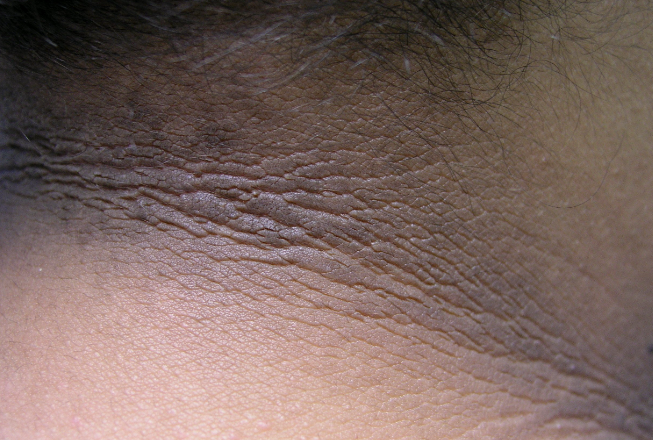Acanthosis nigricans is a group of conditions with different etiology and pathogenesis, characterized by the presence of symmetrical hyperpigmented plaques of hyperkeratosis and papillomatosis, with a predilection for involvement of the skin folds. The ICD-10 code for this condition is L83.
There are four clinical types of acanthosis nigricans:- The benign, or juvenile, form of acanthosis nigricans develops in early childhood and has an autosomal dominant inheritance pattern. With the onset of puberty, rash regresses or remains stationary. The onset of dermatosis is associated with hormonal imbalance.
- The symptomatic form develops under the influence of endocrinopathies, diabetes mellitus, as a result of taking glucocorticoid hormones, estrogens, nicotinic acid, is associated with obesity and often associated with hereditary diseases, being one of the symptoms of syndromic pathology.
- Pseudoacanthosis is also distinguished, which mainly occurs in overweight brunettes and is based on ovarian dysfunction. The process is accompanied by increased sweating, skin trauma, and the disease may regress with weight loss. In this form of black acanthosis, the mucous membranes are never affected.
- The malignant form of acanthosis nigricans is associated with paraneoplastic syndromes and develops in adults due to the involvement of internal organs. The pathogenesis of this form is based on the cellular proliferation of keratinocytes, which is caused by a blastomogenic process. It has been shown that in 61% of cases both processes start simultaneously, in 22% of cases cancer precedes acanthosis and in 17% of cases acanthosis precedes cancer.
The main clinical manifestations of acanthosis nigricans are hyperpigmentation, hyperkeratosis and papillomatosis occurring in the large folds of the neck, clavicle and anogenital areas, accompanied by pruritus. Skin manifestations can develop slowly or, conversely, quite rapidly. Initially, hyperpigmentation, dryness, and thickening of the skin occur, which later takes on a grayish ashen hue. Increased skin folding and numerous small scattered or merging papillomatous and verrucous growths ranging in size from a grain to a pea are formed. The process is symmetrical, localized on the face, neck, armpits, inner surface of thighs, external genitals, inguinal areas, less often - in the area of mammary folds, elbow folds, mucous membranes of oral cavity and tongue. The disease is accompanied by dryness of hair, increased keratinization of palmar-plantar surfaces and nail dystrophy.
Most attention is paid to the malignant form of black acanthosis due to its sudden onset, since according to literature it occurs in 80% of cases in gastric cancer, less frequently in ovarian sarcoma, liver, gallbladder, intestinal, bladder and skin lymphomas. A combination with uterine, esophageal, prostate, and renal cancer has been described. The disease occurs equally in men and women, most commonly between the ages of 40 and 50. In paraneoplastic skin lesions, hyperkeratosis, papillomatosis, and pigmentation are more pronounced than in other forms of the disease. It is characterized by involvement of mucous membranes and weight loss, possible combination with keratoderma, intensification of skin pattern (pachydermatoglyphia), as well as with Leser-Trelat syndrome (sudden appearance of numerous seborrheic keratomas on the skin of the trunk).- Addison's disease (marked hyperpigmentation without papillomatosis in typical areas).
- Contact dermatitis to arsenic or tar (Warty growths predominantly in areas of contact with irritants).
- Post-inflammatory hyperpigmentation
- Lichenification (thickening of the skin) associated with atopic or contact dermatitis

